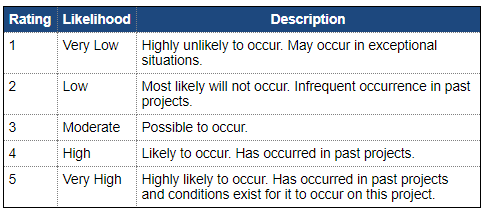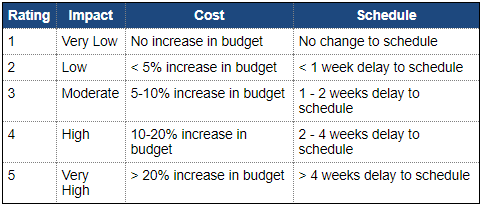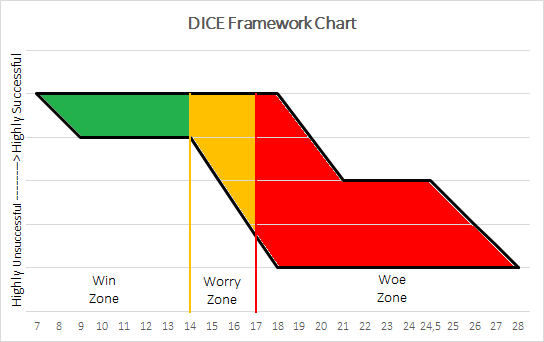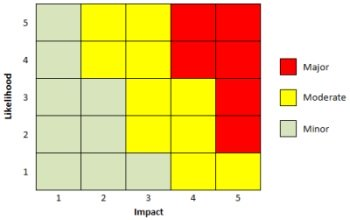DICE Framework
(→Notes) |
(→Big Idea) |
||
| Line 7: | Line 7: | ||
[[File:4 Sided DICE small.png|frame|DICE Framework illustrated by 4 sided dices]] | [[File:4 Sided DICE small.png|frame|DICE Framework illustrated by 4 sided dices]] | ||
This wiki article presents the DICE Framework and goes into its details and how to use it. | This wiki article presents the DICE Framework and goes into its details and how to use it. | ||
| − | Creating successful change is increasingly becoming a factor in the competitive landscape. However, studies show that | + | Creating successful change is increasingly becoming a factor in the competitive landscape. However, studies show that 70% of the transformation efforts fails to reach the intended results <ref>['' https://www.mckinsey.com/business-functions/organization/our-insights/the-irrational-side-of-change-management''] ''The irrational side of change management (2009)'' </ref>. The DICE Framework is a tool that greatly can help an organization to realise a successful project or change. The framework was created by Boston Consulting Group (BCG) who analyzed almost 1000 organizations (PM280) and found a distinct connection on the outcome, regardless of success or failure. The connection lies in the four elements; Duration, Integrity, Commitment and Effort that makes up the DICE Framework. To use the DICE Framework, the different elements has be be accessed and evaluated according to a set of questions. Based on numerical answers, a DICE score can be calculated, which states how likely a project or change is to be successful. The DICE Framework can be used throughout a project to identify areas that needs attention, but can also be used to administer a portfolio of different projects to determine where managers need to put their focus. The framework gives the managers the opportunity to worry about the right things, instead of issues that are less important. If managers have scored differently on the same DICE framework, dialogue is triggered and the framework provides a common platform for discussion. In short, the DICE Framework is a method to assessing and managing risks, especially in change projects. |
Revision as of 22:13, 28 September 2017
Contents |
Notes
This version is a draft of what is to be handed in. Proper referencing is still heavily needed.[1]
A case example on how the framework has been used successfully is still missing [2]
Big Idea
This wiki article presents the DICE Framework and goes into its details and how to use it. Creating successful change is increasingly becoming a factor in the competitive landscape. However, studies show that 70% of the transformation efforts fails to reach the intended results [3]. The DICE Framework is a tool that greatly can help an organization to realise a successful project or change. The framework was created by Boston Consulting Group (BCG) who analyzed almost 1000 organizations (PM280) and found a distinct connection on the outcome, regardless of success or failure. The connection lies in the four elements; Duration, Integrity, Commitment and Effort that makes up the DICE Framework. To use the DICE Framework, the different elements has be be accessed and evaluated according to a set of questions. Based on numerical answers, a DICE score can be calculated, which states how likely a project or change is to be successful. The DICE Framework can be used throughout a project to identify areas that needs attention, but can also be used to administer a portfolio of different projects to determine where managers need to put their focus. The framework gives the managers the opportunity to worry about the right things, instead of issues that are less important. If managers have scored differently on the same DICE framework, dialogue is triggered and the framework provides a common platform for discussion. In short, the DICE Framework is a method to assessing and managing risks, especially in change projects.
Duration
The first element, Duration, is a common element to worry about in a project or change. Many assumes that the length of a project or change is related to the risk of said project or change to fail. The longer the project, the bigger risk of failure. However, studies have shown that it is not about the length of the project, but the frequency of the reviews conducted during the project phase. To make sure that a project is on plan, weekly or monthly reviews are usually necessary. The risk of a project or change failing, is higher if the reviews are too infrequently, which can happen if the project or change is very complex. Scheduling reviews and measuring milestones will greatly increase the odds of the project staying on its path.
Integrity
The second element, Integrity, is the element where the company can rely on the skills and motivation of its managers and employees to successfully execute a project or change. Companies with successful project or change programs, all have employees who are willing to do the routine operational tasks. This willingness is often brought into the projects creating a better environment for the project or change. In projects it is also important to have managers and employees who are cohesive and skillful, since projects often brings various tasks and activities.
Commitment
The third element, Commitment, is important for a project or change success. All members of the team should commit all their time on the project, or the necessary time if the project is to be worked on besides normal day to day routines. If the project is besides normal day to day routines it is important to schedule the time, so the project is not left out. Likewise the managers have to show support and acknowledge the the team members might have the project as a secondary task. The managers must also communicate in a way that leaves no doubt. Often it happens that the communication is misinterpreted, which can cause a wrong project prioritization that can cause conflicts inside the team. Senior management must always be ready to show support for the project and communicate the purpose of it.
Effort
The fourth element, Effort, is how much effort an employee puts into the project. Often it happens when senior management starts a project, they don’t consider the employee's daily operational tasks, which can cause the employees to workload to increase. More than a 10% increase in workload is not recommended. The result can be that the employees are forced to make compromise between the project or daily operational tasks, thus decreasing the quality of the performed work in one or another. Overwork can also cause stress that is bad in the long run. This can cause conflicts in the team and the morale will drop. The senior management has to take responsibility for recruiting employees for the project and to make sure the workload doesn’t increase more than what is recommended.
Understanding the framework
Creating the framework
As BCG researched elements that contributed to projects success, they came to understand a connection, which they later combined into the DICE Framework. They tried calculating a score based on the elements with their past change projects. A distinct result was observed, every project could be put into one of the 3 categories, Win, Worry and Woe. The DICE Framework Chart shows the different categories/zones. BCG created the outline of the chart by mapping all the analysed DICE Scores and creating a frame around it. For example it can be seen that a DICE score between 7 and 14 resulted in usual successful project or changes. A score between 17 and 18 could as well be successful, but due to the risks it could also be highly unsuccessful, but the latter happens more often. From 18 to 28 the risk of the project being highly unsuccessful is increasing. In between the Win Zone and the Woe Zone, the Worry zone is where it is hard to predict whether the project or change will be successful or not. It can happen that the outcome of a project or change is outside the boundaries of the chart, however this seldom occurs and the framework should be seen as guidance.
The DICE Framework Chart can be used by the company to map all past project scores, to keep track of successful and unsuccessful projects or changes.
Calculating the score
By asking executives and managers about the four elements of the DICE Framework (Duration, Integrity, Commitment and Effort), companies can determine if a project or change will be successful. Each element has to be graded numerically from a scale from 1 to 4 where fractions can be used. The score of 1 suggests that the element will contribute highly to the success of the project or change, where the score of 4 suggests that it is very unlikely to contribute positively.
| Element | Question | Score |
|---|---|---|
| Duration (D) | How often does project reviews happen? Does it happen regularly? How long will the project take? | If the duration of the project is less that 2 month, a score of 1 should be given. If the duration of the project is between 2 and 4 month, a score of 2 should be given. If the duration is between 4 and 8 months, a score of 3 should be given. If more than 8 months, a score of 4 should be given. |
| Integrity (I) | Is the team leader capable? Is the team skilled and motivated? Do the team have enough time to spend on the project? | If the team leader is highly capable and is respected by the team, and the team is skilled and motivation to complete the project in its planned duration, and the team members have been assigned at least 50% of their time for the project, the score should be 1. If none of the questions is fulfilled, a score of 4 should be given. If it is somewhere in between a score of 2 or 3 should be given. |
| Commitment from senior management (C1) | Does senior managers regularly communicated the purpose of the project or change? Is the message convincing? Is it consistent across both the top management team and over time? Is there devoted enough resources for the project or change? | If senior management has clearly communicated the purpose of the project or change, both in actions and words, the score should be 1. A score between 2 and 3 should be given if the senior management is neutral to the project or change. If the senior management is reluctant to the project or change, a score of 4 should be given. |
| Commitment, local-level (C2) | Does the employees and team members most affected by the project or change understand the reason for it and will they think the project or change is worth the time? Are they very interested and supportive for the project or change? | If the employees and team members are very interested and supportive of the project or change, a score of 1 should be given. If they are just willing, a score of 2 should be given. A score between 3 and 4 should be given depending on strongly they oppose the project or change. |
| Effort (E) | How much is the workload going to be increased with the project or change? Is the additional workload going to be on top of an already tough one? Have the employees objected to the increase of workload? | If the increase of workload is below 10%, a score of 1 should be given. If the workload increase is between 10% and 20%, a score of 2 should be given. If it is between 20% and 40%, then a score of 3, and a score of 4 if it is above 40%. |
Combining the score
After the different elements with their questions have been answered, senior management can calculate a DICE score. The equation follows:

With scores ranging from 1 to 4, then a total range of score can vary between 7 and 28. The company can compare the calculated score with pasts scores from other projects to assess if the current project is going to be successful.
A score between 7 and 14 is called to Win Zone, this is where the project or change is likely to succeed.
A score between 14 and 17 is called the Worry Zone, this is where the risks are increasing, where a higher score has higher risks.
A score above 17 is called the Woe Zone, this is where the project is excessively risky, where a score above 19 is considered unlikely to be successfully.
Application
Track projects
Senior management often uses spreadsheet version of the DICE Framework to calculate the DICE Score. In the same document, the score can be compared to scores from older projects or past scores from same project. The DICE Score is frequently used by the senior management to look for early warning signals that a project or change is in problems. By frequently doing reviews of the ongoing project or change, herein using the DICE Framework, problems are faster to recognise and react on. If suddenly the DICE Score from a review is higher than in the past, senior management can reconfigure the teams and allocate additional resources among other to get project back on track. Senior management can as well track multiple projects, by using the DICE Framework with the different project managers, they can establish which projects to worry about. If a project is on the wrong track, senior management can move managers from the most healthiest projects to unhealthier projects for assistance, moreover they can add milestones and postpone the completion of the project in turn for hard improvements to make sure they meet their objectives. However the resources and their accessibility can differ making the right decision on how to assist problematic projects different from company to company.
Manage portfolios of projects
Especially during large change programs, companies tend to initiate many projects to reach the overarching objectives. Senior management have to be careful when managing the portfolio of projects to avoid projects taking away attention and resources from other projects. For example might senior management allocate the best employees for sponsored projects or give high attention for personal favored projects. By using the DICE Framework on the portfolio of projects, before initiation, they can identify the projects that can become problems later. A case example about an Australian manufacturer highlights the importance of good portfolio management. They had 40 different change projects ongoing to increase profitability in their company, where some of the project had greater financial implications that others. The general manager called for a a meeting, using the DICE Framework with both project leaders and senior management to identify the different scores. They identified 5 projects to be the most promising, well into the Win Zone, and highlighted that they should wait initiating those projects before some of the less promising projects, in the Worry Zone, had gained the necessary attention and resources so they as well could be moved into the Win Zone. Before the initiation of any projects, the company had now the opportunity of correctly address the team configurations, resource allocations and where the senior management should put their attention. Some projects happened to remain in the Worry Zone, but closely monitored for improved score. BCG who conducted this case study recommends companies to have change projects starting off in the Worry Zone, to truly create fundamental changes. This does not imply the managers to purposefully removing resources and attention from projects, but should happen from natural causes out of ambition.
Force conversation
Depending on the senior manager that calculates the DICE Score, different outcomes can arise. This can happen because the senior managers sees the healthiness of a project differently or they themselves are informed differently or questionably among other. This will in most cases force conversations between senior management, trying to align themselves with each other. The conversation can spark questions such as “why is the project seen differently?” and “what can be agreed on to make sure the project is successful?”. The questions asked during the scoring of DICE can as well be used as a framework of discussion and is ideal to create a common language. The common language is especially useful when the conversations are for large change programs covering multiple departments across borders, but also when the reviews are conducted on different levels of the company, from top management to the managers on the workshop floor.
Limitations
The DICE Framework makes an effort to measure projects before and after initiation in a more objectively way. The DICE utilizes hard factors to calculate a score, omitting soft factors that could have bigger influence on the success of a project. Soft factors such as motivation, culture and vision can be harder to measure objectively. The DICE Framework could in such cases be highly misleading.
The scoring in the DICE Framework are mostly subjective, which can make senior management undershoot or overshoot the scoring, making the chance of success for the project seem higher or lower. This could lead to wrong decisions when allocating resources, employees or attention among different projects.
The subjective scoring can and will often make different managers score differently on the DICE Framework, even the same manager could in principle score differently depending on the time of day or if they have been influenced by external personal stuff, both good and bad. The reproducibility is therefore hard to create between different managers.
The DICE Framework is a simple method to evaluate risks in projects, but the simplicity of it makes managers look for other methods seeking more complex answers. This, however, can cause the managers to overlook the obvious and make wrong compromises (HBR116). The method is as well only providing the managers with a guidance on how to identify and assess the 4 elements of DICE in a project, but does not give any guidance on what to do to move the project(s) from the Woe or Worry Zone to the Win Zone. The managers have to figure that out themselves. Some managers seeks the whole package (PicRecipe), thus making the DICE Framework come out short.
BCG notes that the DICE Framework is suited best for large-scale transformations that cut through departments and across borders. It can therefore be argued whether it will work sufficiently in small companies with few projects (Dmitry Uspenskiy).
A criticism of the DICE Framework is that it doesn’t take into consideration the impact, benefit or urgency the project will have on the company, when it is used to prioritize or compare projects or programs. The method is focused on the chance a project have to succeed and not the payoff (Dmitry Uspenskiy).
Other Methods
Bechard’s Change Formula
Bechard’s Change Formula is another method to calculate a change project’s success. Where a higher score means better.
Ps: Chance of success
D: Degree of dissatisfaction with current situation
V: Compelling vision for new state
F: Effectiveness of the first steps
R: Resistance to change
Bechard’s Formula is more conceptual and is harder to use practically, where the DICE formula evaluates elements on the same scale, thereby allowing for creating ranges of scores that can be classified upfront. Bechard’s formula leaves the manager to interpret the results (Dmitry Uspenskiy). The narrow view of factors in Bechard’s formula, and especially only one denominator makes the formula risky to use, since only resistance to change can lower the result of success and not other factors such as resources or available employees.
Other Risk Evaluating Tools
Qualitative Risk Analysis is a method for prioritizing risks based on the probability of occurring and the impact it will make if it occurs. The qualitative risk analysis uses the risk assessment matrix to plot risks into. By using a likelihood scale and an impact scale, the managers can rate the different risks that can face the project and develop plan how to avoid, transfer, mitigate or accept the risks. Depending on the risks, senior management can allocate more resources, attention or employees to avoid, transfer or mitigate the risks.
 Likelihood Scale Example
Likelihood Scale Example
 Impact Scale Example
Impact Scale Example
Annotated Bibliography
Will come in the second edition.
References
- ↑ Plunkett, John. "Sorrell accuses Murdoch of panic buying", The Guardian, London, 27 October 2005. Retrieved on 27 October 2005.
- ↑ [ http://sloanreview.mit.edu/article/what-successful-project-managers-do/] What Successful Project Managers Do (2015)
- ↑ [ https://www.mckinsey.com/business-functions/organization/our-insights/the-irrational-side-of-change-management] The irrational side of change management (2009)



